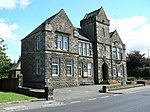Bonnybridge railway station
Disused railway stations in Falkirk (council area)Former Caledonian Railway stationsPages with no open date in Infobox stationRailway stations in Great Britain closed in 1930Railway stations in Great Britain opened in 1886 ... and 1 more
Use British English from December 2016
Bonnybridge railway station was a railway station serving the village of Bonnybridge in central Scotland. The station was located on a short branch off the Caledonian Railway line from Coatbridge to Larbert. (There were two other "Bonnybridge" stations, on the Edinburgh and Glasgow main line and the Kilsyth line respectively.)
Excerpt from the Wikipedia article Bonnybridge railway station (License: CC BY-SA 3.0, Authors).Bonnybridge railway station
Broomhill Road,
Geographical coordinates (GPS) Address Phone number Website Nearby Places Show on map
Geographical coordinates (GPS)
| Latitude | Longitude |
|---|---|
| N 55.9974 ° | E -3.8876 ° |
Address
Antonine Primary School
Broomhill Road
FK4 2AN
Scotland, United Kingdom
Open on Google Maps







